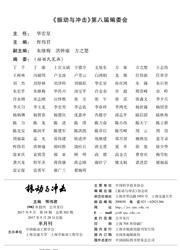

 中文摘要:
中文摘要:
This work addresses the problem of self-excited vibration,which degrades the stability of the levitation control,decreases the ride comfort,and restricts the construction cost of maglev system.Firstly,a minimum model containing a flexible bridge and a single levitation unit is presented.Based on the simplified model,the principle underlying the self-excited vibration is explored.After investigations about the energy transmission between the levitation system and bridge,it is concluded that the increment of modal damping can dissipate the accumulated energy by the bridge and the self-excited vibration may be avoided.To enlarge the equivalent modal damping of bridge,the sky-hooked damper is adopted.Furthermore,to avoid the hardware addition of real sky-hooked damper,considering the fact that the electromagnet itself is an excellent actuator that is capable of providing sufficiently fast and large force acting on the bridge to emulate the influence of the real sky-hooked damper,the technique of the virtual sky-hooked damper is proposed.The principle underlying the virtual sky-hooked damper by electromagnet is explored and the vertical velocity of bridge is estimated.Finally,numerical and experimental results illustrating the stability improvement of the vehicle-bridge interaction system are provided.
 英文摘要:
英文摘要:
This work addresses the problem of self-excited vibration, which degrades the stability of the levitation control, decreases the ride comfort, and restricts the construction cost of maglev system. Firstly, a minimum model containing a flexible bridge and a single levitation unit is presented. Based on the simplified model, the principle underlying the self-excited vibration is explored. After investigations about the energy transmission between the levitation system and bridge, it is concluded that the increment of modal damping can dissipate the accumulated energy by the bridge and the self-excited vibration may be avoided. To enlarge the equivalent modal damping of bridge, the sky-hooked damper is adopted. Furthermore, to avoid the hardware addition of real sky-hooked damper, considering the fact that the electromagnet itself is an excellent actuator that is capable of providing sufficiently fast and large force acting on the bridge to emulate the influence of the real sky-hooked damper, the technique of the virtual sky-hooked damper is proposed. The principle underlying the virtual sky-hooked damper by electromagnet is explored and the vertical velocity of bridge is estimated. Finally, numerical and experimental results illustrating the stability improvement of the vehicle-bridge interaction system are provided.
 同期刊论文项目
同期刊论文项目
 同项目期刊论文
同项目期刊论文
 Nonlinear Robust Observer-Based Fault Detection for Networked Suspension Control System of Maglev Tr
Nonlinear Robust Observer-Based Fault Detection for Networked Suspension Control System of Maglev Tr Adaptive backstepping control for levitation system with load uncertainties and external disturbance
Adaptive backstepping control for levitation system with load uncertainties and external disturbance 期刊信息
期刊信息
